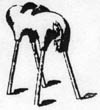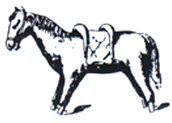| . |
A
look at the history of the vaulting horse shows us that it developed
from the wooden horse with pommels. (See
"From
wooden horse to Pegases")
Even
Alexander the Great and his Macedonians are
said to have practised mounting and dismounting on a wooden horse. In
the 4th century Vegetius describes Roman soldiers using wooden
horses for practice in his “Overview of the Roman Army". Somebody
must have remembered Vegetius' work in the 17th century and
expanded what was originally part of military training into a sporting
activity. Equestrian acrobatics was an important part of the education
at academies for knights and fencing schools up until the late 18th
century, and a great number of manuals date from this time.
Models of the pommel horse from various eras:

Vieth
model 1795,
Height was already adjustable |

Guts
Muths model around 1800,
with
iron biegels
|

Jaeger
model around 1860,
wooden horse with leather cover |

Belgian
model,
with odd feet, fully symmetric |
| In
the early 19th century, when Jahn, regarded as the
father of gymnastics, was alive,
there were three different kinds of horses on the Hasenheide
in Berlin: One very close to reality with a head and a tail,
one made of leather without a tail but with an ascending neck
and the wooden schwingel
a word which F.L. Jahn, who detested the use of foreign
words in German, had created to avoid the originally French
word of Voltegieren. The latter developed into the Olympic apparatus of pommel
horse
|

Gymnastic horse 1811
|
At
the beginning of the 20th century
gymnastics horses had to fulfil the following requirements (quoted from
Jahrbuch der Turnkunst 1907):
|
|

Horse, 1900 (Germany)
|
“The
length of the horse should by 190cm.” Required height is cited
as between 110 and 170cm. Height of the body 40cm, width on
top 40cm and below 37cm. Neck and end are equal since the saddle,
i.e. the distance between the pommels, is 44 to 45cm, leaving
72cm each for neck and end. The pommels are 11-12 cms high and
30 to 32cm thick. Horses with longer necks (asymmetric) where
the neck was bent upwards in slightly crooked way, were also
common. Around 1920 a completely symmetric horse existed (R.
Gausch manual), however, head and rump had different lengths.
The top of the horse remains round (this will not change for
a long time), and shows no signs of allowing wandering movements
that would later become popular in the world of gymnastics.
Another feature making this development impossible were the
round pommels, which hardly allowed for the support of both
hands as is typical of the wandering movements. A 1926 model
of the pommel horse had a more sleek look to the torso and the
lower part lightly curves upwards. This type of horse was still
used at the 1936 Berlin Olympics. It was only 180cm long. Gymnasts
already competed swinging elements on the neck as well as the
rump. |
The
Americans brought a version of the horse to the 1948 Olympics
that was only 160cm long and was built completely symmetrically. As
a result, they were able to show totally new combinations and great
virtuosity in their leg circles on the end of the horse.
At a meeting in Venice, Italy, in 1955 the International
Gymnastics Federation’s apparatus committee discussed the horse with
a length of only 160cm, which was already being widely used in Switzerland,
and a year later it was finally officially certified at a meeting in
Boppard, Germany. From now on, one no longer spoke of neck and rump,
but of two equal “ends”. Pommel horse artists such as Grant Schaginjan
performed with incredible virtuosity on this horse at the 1954 world
championships. Their technique had a major influence on the further
development of the apparatus.
The
development of the pommels largely
depended on the type of use. As long as the horse was used mainly for
jumping and equestrian acrobatics were merely a dry run for riding,
the pommels didn’t have any special function. But once gymnasts began
swinging in the support position – first with one leg, and in the middle
of the 19th century the two-legged swing became popular-
this influenced the form of the pommels. Swiss gymnastics was particularly
progressive during this period and in the 1880s the pommel horse spread
into German gym clubs as well. The standard pommel was hollow, mostly
made from iron in the beginning, but in later years wood was also used.
Some of the pommels were covered in leather. The pommels of the horse
used at the 1936 Olympics were noticeably flatter in comparison to the
earlier ones.
This trend continued in the mid 1950s.
Pommel horse artists forced the further development of the apparatus
through new elements. Examples are Yu Lifeng of China and his circles
on one pommel at the 1962 world championships in Prague or pommel horse
specialist Russel Mills, who showed circles in cross support on one
pommel in 1964. Then, of course, Miroslav Cerar, Zoltan Magyar… The
call for pommels that allowed for a fleeting double hold/grip at an
equal height of the pommels became louder and louder. In 1974 the pommels
were lengthened from 280 to 310mm. At the 1975 Gymnastrada in Berlin
a revolutionary new pommel was introduced – machine manufactured, it
was made entirely from plastic. Another novelty was the distance between
the pommels (400 to 450mm), which was adjustable without any steps.
(Translation:
Nora Schuler)
|
|
The
apparatus we see in competitions today,
for instance the type manufactured by Janssen & Fritsen,
Official Suppliers of the 2000 World Championships in Gent,
is a top level apparatus which is certified by the FIG.
The durable rump is covered in high quality leather and foam
rubber.
Its pommels are made entirely of plastic and chains anchor it
to the ground. Height can be adjusted in steps of 5 cm between
110 and 150 cm.
 .....
read more, please! .....
read more, please!
|

|
| |
| Sources/Quellen:
"Der Vorturner", 1927/28; "Das Turnjahrhundert
der Deutschen", Götze/Herholz: Beckmanns Sportlexikon A-Z,
Leipzig, Wien 1933; "Deutsche Turnzeitung", 1901;
"Neue deutsche Turnzeitung", 1961, J. Leirich; "Geschichte
der Turngeräte", J. Göhler/R. Spieth; "Mondsalto",
gymbooks Verlag 1994, A. Götze/J. Uhr; "FlickFlack...",
Sportverlag Berlin, A .Götze/H.-J. Zeume; "The History
of British Gymnastics", 1988 by BAGA. |
|







